Range Rover Evoque: Cylinder Head Components - 2.0L GTDi
Component Description
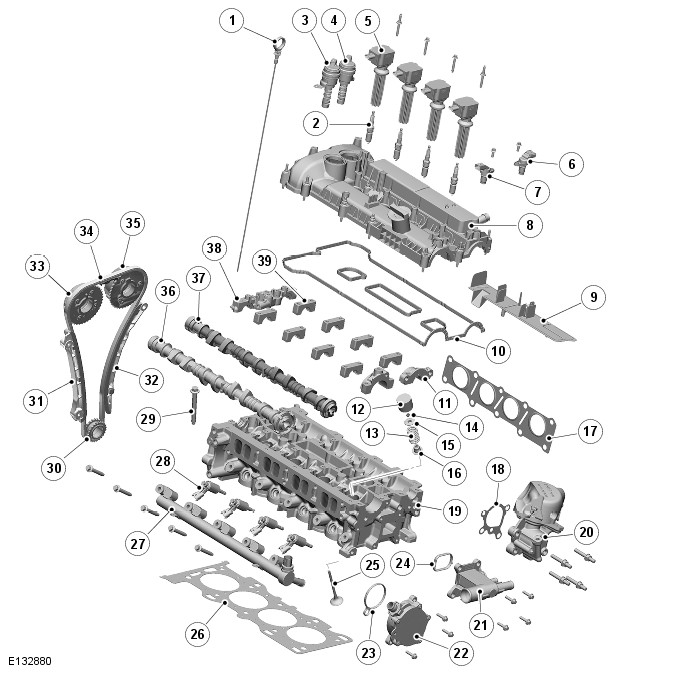
- Oil level gage
- Spark plug (4 off)
- Variable valve timing solenoid valve - Inlet camshaft
- Variable valve timing solenoid valve - Exhaust camshaft
- Ignition coil and plug cap (4 off)
- Camshaft Position (CMP) sensor - Exhaust camshaft
- CMP sensor - Inlet camshaft
- Camshaft cover
- Camshaft cover baffle plate
- Gasket - Camshaft cover
- Rear camshaft bearing cap (2 off)
- Hydraulic camshaft follower (16 off)
- Valve spring (16 off)
- Valve spring collet (32 off)
- Valve spring retainer (16 off)
- Valve spring seat and valve stem oil seal (16 off)
- Gasket - Exhaust manifold
- Gasket - High Pressure (HP) fuel pump
- Cylinder head
- HP fuel pump and housing assembly
- Water outlet connection
- Vacuum pump assembly
- Gasket - Vacuum pump
- Gasket - water inlet
- Valve - (8 off inlet - 8 off exhaust)
- Cylinder head gasket
- Fuel rail
- Fuel injector (4 off)
- Cylinder head bolt (10 off)
- Crankshaft drive gear - Camshaft timing and oil pump chain
- Camshaft timing chain guide
- Camshaft timing chain tensioner arm
- Variable Camshaft Timing (VCT) actuator - Inlet camshaft
- Camshaft timing chain
- VCT actuator - Exhaust camshaft
- Camshaft - Inlet
- Camshaft - Exhaust
- Front camshaft bearing cap
- Camshaft bearing cap (8 off)
Cylinder Head
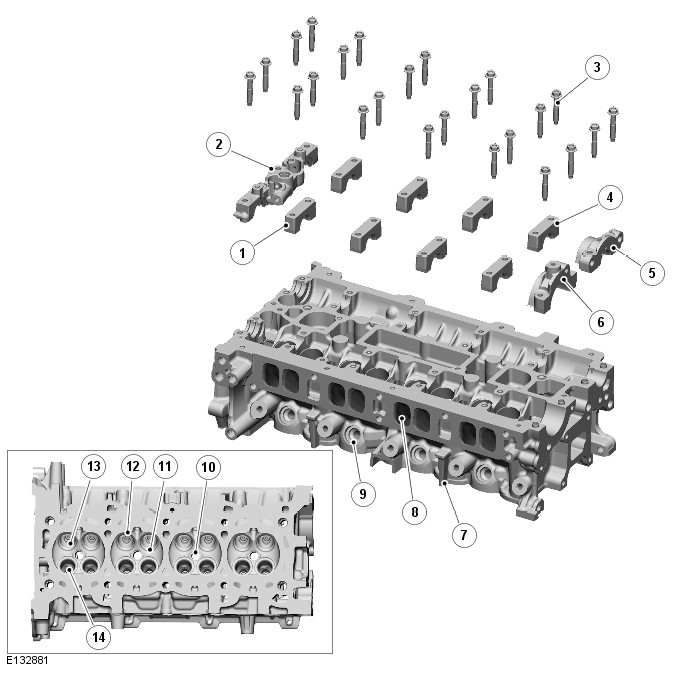
- Inlet camshaft bearing cap (4 off)
- Front camshaft bearing cap
- Nut, washer and stud (24 off)
- Exhaust camshaft bearing cap (4 off)
- Rear exhaust camshaft bearing cap
- Rear inlet camshaft bearing cap
- Cylinder head
- Inlet ports
- Fuel injector location (4 off)
- Spark plug location (4 off)
- Valve seat (8 off inlet - 8 off exhaust)
- Valve guide (16 off)
- Inlet valve location
- Exhaust valve location
The cylinder head is cast from aluminum alloy. The cylinder head provides location for two camshafts, sixteen valves, four injectors and four spark plugs.
Each cylinder has four valves. To help achieve the required gas-flow characteristics, these are arranged asymmetrically around the cylinder bore. Each cylinder has a centrally mounted spark plug.
The four fuel injectors are located on the inlet manifold side of the cylinder head and direct fuel into the combustion chamber from between the inlet valves. The injectors are retained in the cylinder head by the direct injection fuel rail.
Each camshaft is held in the cylinder head by 4 bearing caps, a front bearing cap and a rear bearing cap. The bearing caps are retained with a combination of bolts and studs, washers and nuts.
Camshaft Cover
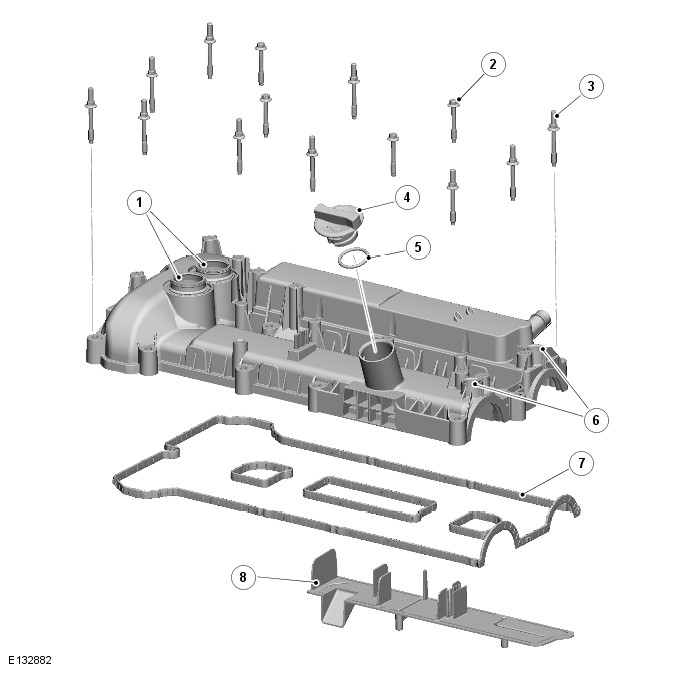
- VCT solenoid valve locations
- Bolt (4 off)
- Stud, washer and nut (10 off)
- Oil filler cap
- O ring seal
- CMP sensor locations
- Gasket
- Baffle plate
The camshaft cover is manufactured from molded plastic. The cover is secured to the cylinder head with four bolts and ten studs, washers and nuts.
The cover provides the location for the VCT (variable camshaft timing) solenoid valves and also the CMP (camshaft position) sensors.
Threaded inserts in the molding allow for the attachment of brackets for the air intake duct to the turbocharger and also for the attachment of the engine cover, ignition coils, CMP sensors and VCT solenoid valves.
A groove in the outer edge of the cover provides the location for the cover re-usable rubber sealing gasket. Three separate sections of the seal, located in the center of the cover engine, prevent oil leaking into the into the area around the coils and spark plug caps.
Valves and Followers
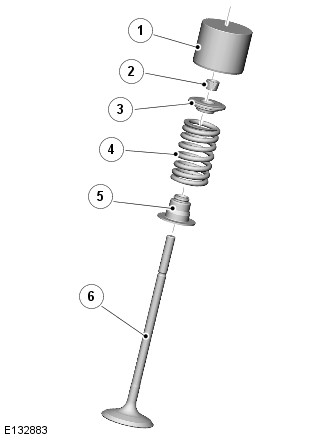
- Cam follower
- Valve collet
- Valve spring retainer
- Valve spring
- Valve spring seat and valve stem oil seal
- Valve
The engine uses sixteen stainless steel valves; eight inlet and eight exhaust. The inlet valves are 35 mm diameter and the exhaust valves are 29.9 mm, The large valves allow for large cylinder head ports which contribute to increased engine power output and improved emissions. The valve stems are 5.4 mm which allows for reduced flow interruption through the inlet and exhaust ports, again improving power and emissions.
the valves are conventionally located in valve guide in the cylinder head. A valve seat with integral valve stem seal is located in the cylinder head. The valve spring is retained on the valve stem by a spring seat and split collets.
The valves are opened mechanically by a bucket design cam follower which is operated directly by the associated camshaft lobe. The valve clearance is set by selection of the appropriate cam follower to achieve the required clearance.
Camshafts
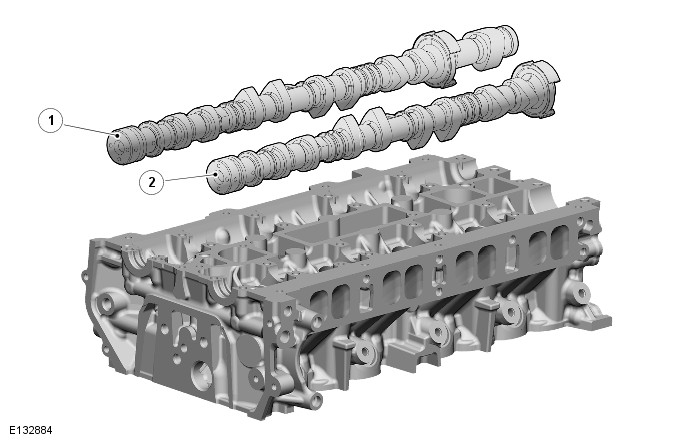
- Exhaust camshaft
- Inlet camshaft
Two, one-piece cast camshafts are used. The exhaust camshaft is extended and protrudes through the end of the cylinder head. The extension has a three sided cam which drives the high pressure fuel pump.
Each camshaft has eight, high lift, short duration cam lobes which open and close the valves. A sensor ring is shrunk onto each camshaft and is used to determine the camshaft position. A CMP sensor, located in the camshaft cover above the sensor ring for each camshaft, senses the position of the camshaft and passes this information to the ECM. The ECM uses this information and position data from the CKP sensor to determine the current position of the crankshaft and camshafts.
This is used for a number of engine functions including VCT operation and ignition timing.
Camshaft Position (CMP) Sensors
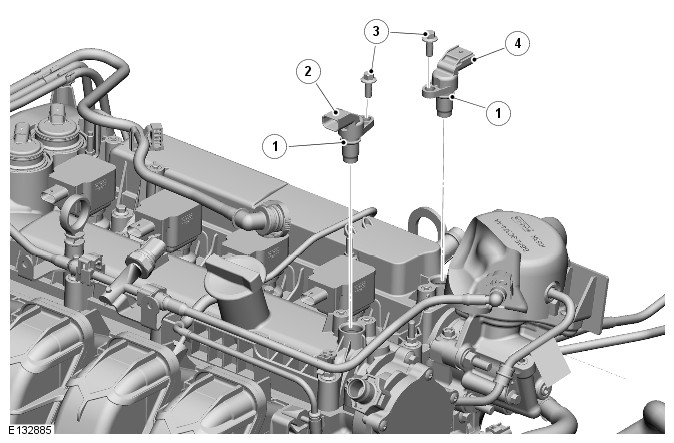
- O ring seal (2 off)
- Inlet camshaft CMP sensor
- Bolt (2 off)
- Exhaust camshaft CMP sensor
The CMP sensor are located in the camshaft cover. They are each sealed with an O ring seal and secured in the cover with a bolt.
EachCMP sensor is located above a sensor ring on each camshaft. The sensor determines the position of the camshaft by a gap in the sensor ring and passes this information to the ECM. The ECM uses this information and position data from the CKP sensor to determine the current position of the crankshaft and camshafts. This is used for a number of engine functions including VCT operation, fuelling and ignition timing.
Refer to: Electronic Engine Controls (303-14B Electronic Engine Controls - GTDi 2.0L Petrol, Description and Operation).
Camshaft Timing Chain
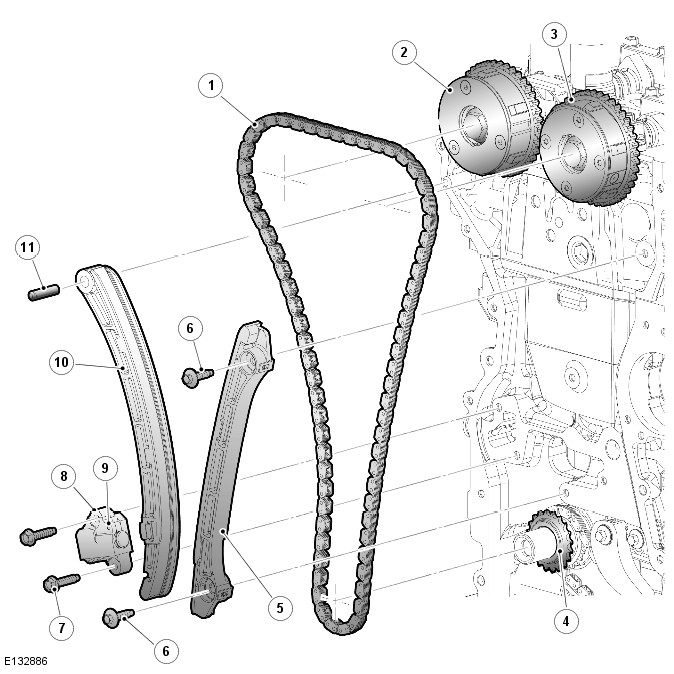
- Camshaft timing chain
- Camshaft gear and VCT actuator - Exhaust camshaft
- Camshaft gear and VCT actuator - Inlet camshaft
- Camshaft timing chain and oil pump crankshaft drive gear
- Camshaft timing chain guide
- Bolt - camshaft timing chain guide (2 off)
- Bolt (2 off)
- Timing chain tensioner
- Tensioner locking hole
- Camshaft timing chain tensioner arm
- Pin - tensioner arm pivot
The simplex camshaft timing chain is an endless roller chain which is driven by a gear on the crankshaft. The chain is passed over the two gears which are integral with the VCT actuators on the end of each camshaft.
NOTE: If the front pulley is removed, the engine must be set and held at TDC to maintain the engine timing.
A fixed camshaft timing chain guide is fitted to the inlet side of the engine and secured with two bolts. A tensioner arm guide is fitted to the exhaust side of the engine and is attached with a pivot pin at its upper end. A camshaft timing chain tensioner is fitted to the lower end of the tensioner arm and applies a controlled tension to the chain. This maintains the chain at the correct tension and also allows for and dampens backlash in the chain tension due to deceleration. The chain and tensioner are maintenance free components.
The tensioner has a hole which allows for the locking of the tensioner to facilitate removal of the tensioner arm, guide or camshaft timing chain. The tensioner plunger can be pushed back into the housing and a pin inserted to lock it in the retracted position.
The tensioner is also responsible for lubrication of the timing chain. The tensioner is mounted in a oil pressure gallery on the cylinder block which also supplies pressurized engine oil to the turbocharger. Pressurized oil is passed through the tensioner body and into a drilling in the center of the tensioner plunger. The pressurized oil is ejected from a small hole in the end of the tensioner plunger and passed though a corresponding hole in the tensioner arm and apples engine oil to the chain.
Camshaft Timing Chain Cover
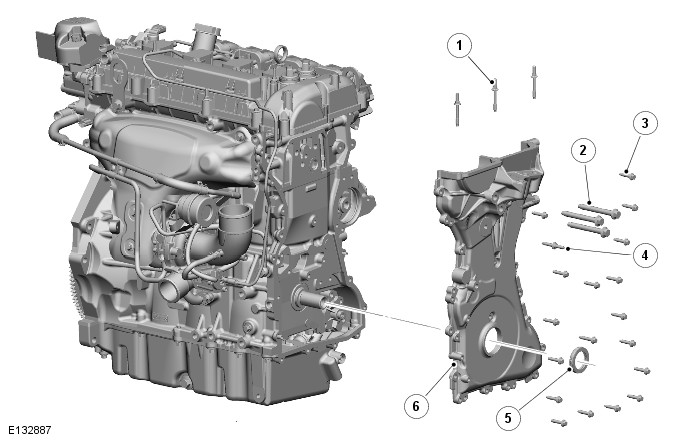
- Stud, washer and nut - Camshaft cover (3 off)
- Bolt M10 (3 off)
- Bolt M6 (16 off)
- Stud, washer and nut
- Crankshaft oil seal
- Cam chain cover
The cam chain cover is located on the front of the engine and is secured to the cylinder block and cylinder head with sixteen M6 bolts, three M10 bolts and four studs. The cover is sealed to the cylinder block and cylinder head with application of RTV sealer.
The cover housing the front crankshaft oil seal and also provides location for the front engine mounting bracket and damper assembly. Two threaded bosses near the bottom of the cover provide for the attachment of the CKP sensor.
Variable Camshaft Timing (VCT) Actuators
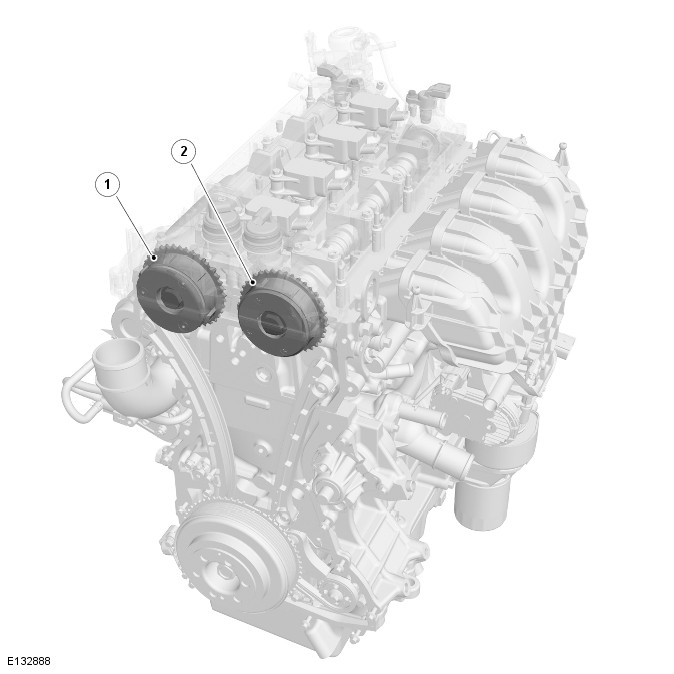
- Exhaust camshaft VCT actuator
- Inlet camshaft VCT actuator
The timing of the inlet and exhaust camshafts can be adjusted independently by an electro-hydraulic controlled VCT system. The ECM controls the system using information from the CMP sensors and the CKP sensor.
The VCT actuators are located on the end of each camshaft and are secured with diamond friction washers and bolts to threaded holes in each camshaft. No keyway is used to maintain the timing of the VCT actuator to the camshaft position, the diamond friction washers lock the actuator in position. The friction washers can only be used once and must be replaced if the actuators are removed.
The VCT actuators are operated by VCT solenoid valves. The solenoid valves are controlled by the ECM to control the flow of pressurized engine oil to the actuators.
VCT Actuator - Exhaust Camshaft
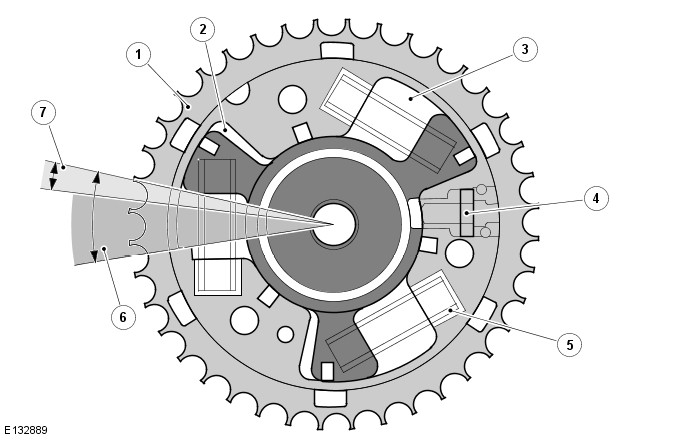
- VCT actuator unit - exhaust camshaft
- Chamber - retard adjustment
- Chamber - advance adjustment
- Locking pin
- Return springs (6 off)
- Maximum adjustment angle
- Free play in locked home position 0.25 - 0.75 degrees
The exhaust camshaft VCT actuator has three hydraulic chambers. Six return springs are used to ensure the camshaft drive gear is returned to the 'home' position as quickly as possible.
The three chambers allow hydraulic pressure to act on the central piston. The pressure is effectively directed into the three chambers and consequently applied to the three 'pistons' which are moved by the pressurized engine oil when advance or retard adjustment is required. The pressurized engine oil is supplied from the engine oil pump. The flow of the oil to the actuator is controlled by the VCT actuator solenoid valve which in turn is controlled by the ECM.
When advance or retard of the camshaft timing is required, the solenoid valve directs the pressurized engine oil into one side or the other of the central piston chambers. The central piston is attached directly to the camshaft. The hydraulic effect of the oil rotates the camshaft in relation to the outer gear of the VCT actuator, therefore changing the valve timing.
Springs within the unit assist the camshaft to quickly return to the normal operating position assisted by hydraulic pressure being applied to the opposite side of the piston.
VCT Actuator - Inlet Camshaft
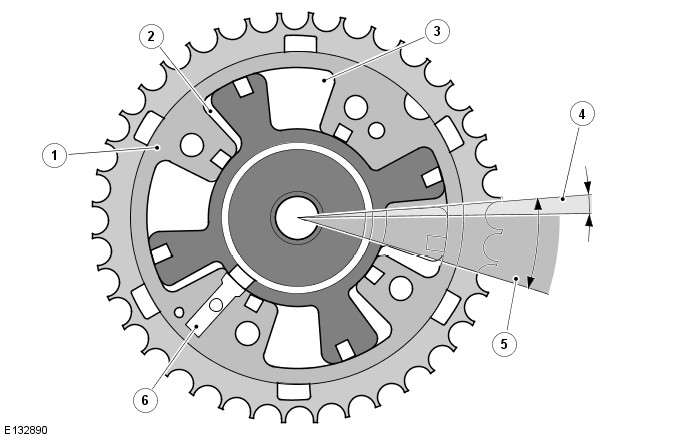
- VCT actuator unit - inlet camshaft
- Chamber - advance adjustment
- Chamber - retard adjustment
- Free play in locked home position 0.25 - 0.75 degrees
- Maximum adjustment angle
- Locking pin
The inlet camshaft VCT actuator has four hydraulic chambers. The additional chamber when compared to the exhaust camshaft VCT actuator gives greater adjustment torque.
The four chambers allow hydraulic pressure to act on the central piston. The pressure is effectively directed into the four chambers and consequently applied to the four 'pistons' which are moved by the pressurized engine oil when advance or retard adjustment is required. The pressurized engine oil is supplied from the engine oil pump. The flow of the oil to the actuator is controlled by the VCT actuator solenoid valve which in turn is controlled by the ECM.
When advance or retard of the camshaft timing is required, the solenoid valve directs the pressurized engine oil into one side or the other of the central piston chambers. The central piston is attached directly to the camshaft. The hydraulic effect of the oil rotates the camshaft in relation to the outer gear of the VCT actuator, therefore changing the valve timing.
Variable Camshaft Timing (VCT) Solenoids
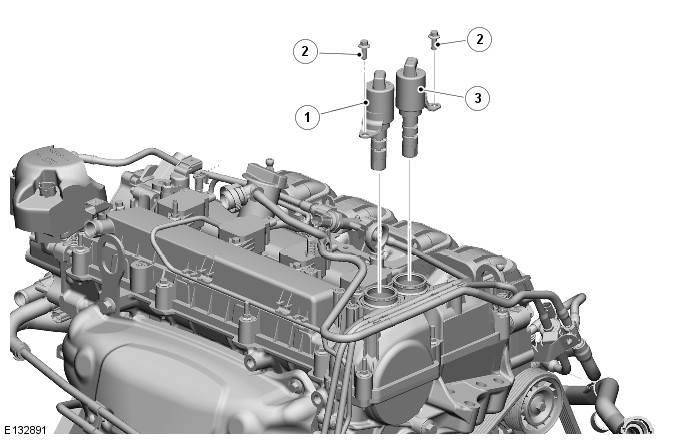
- Exhaust camshaft - Solenoid valve
- Bolt (2 off)
- Exhaust camshaft - Solenoid valve
Two VCT actuator valve solenoid valves are used; one for the inlet camshaft and one for the exhaust camshaft. The solenoid valves are located in the top of the camshaft cover and are secured with a bolt and sealed with O ring seals assemblies.
The solenoid valves are located in holes in the front camshaft bearing cap. The bearing cap contains drillings which direct pressurized engine oil to the valve control ports. The pressurized engine oil is supplied through a central bore in the bearing cap. The bore contains a filter to remove any debris from the oil to avoid contamination of the solenoid valves spools. The oil passes through the filter and is directed via drilling to each solenoid valve spool.
The valve spool is moved by the solenoid which is actuated by PWM (pulse width modulation) signals from the ECM.
Each VCT actuator solenoid valve contains a coil and an armature. The ECM actuates the solenoid with a PWM of up to 300 Hz. The solenoid valve is controlled linearly over its operating range from 0 to 1000 mA. Approximately 560 mA is required to hold the valve in the neutral position so the oil supply to the retard and advance adjustment control ports are closed.
If the ECM detects a fault with one or both VCT actuator solenoid valves, the ECM will not operate them and therefore VCT operate will be disabled and the camshaft will operate in their default position.
VCT Actuator Solenoid Valve - Sectional View
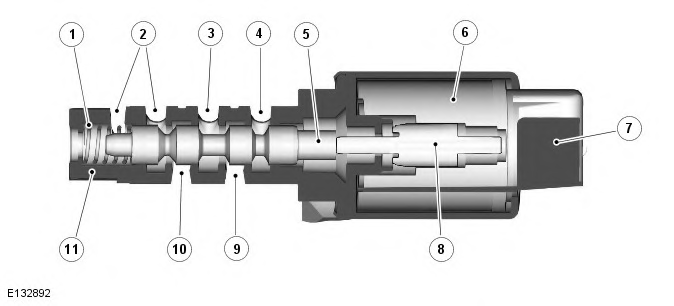
- Return spring
- Return control port - advance adjustment
- Oil pressure supply port
- Return control port - retard adjustment
- Valve spool
- Solenoid coil
- Electrical connector
- Armature
- Oil pressure control port - (retard adjustment - intake camshaft or advance adjustment - exhaust camshaft)
- Oil pressure control port - (advance adjustment - intake camshaft or retard adjustment exhaust camshaft)
- Valve body
Spark Plugs and Coils
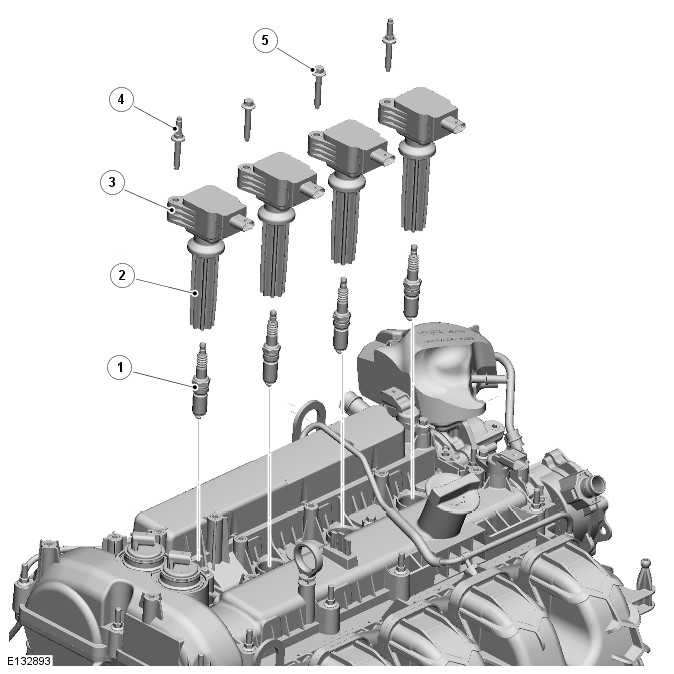
- Spark plug (4 off)
- Plug cap (4 off)
- Ignition coil (4 off)
- Stud, washer and nut (2 off)
- Bolt (2 off)
Four spark plugs are located in recessed threaded bosses in the top of the cylinder head. The ignition coil and spark plug cap are combined and are secured in the head with two bolts for the two inner coils and two studs, washers and nuts for the outer coils.
High Pressure (HP) Fuel Pump
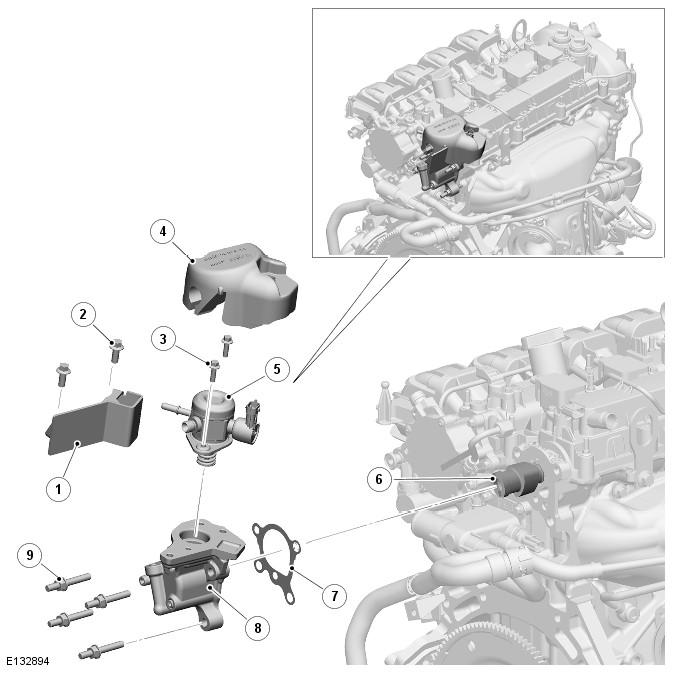
- Fuel pump shield
- Bolt - NVH cover (2 off)
- Bolt (2 off)
- Acoustic cover
- High pressure fuel pump
- Exhaust camshaft lobe
- Gasket
- Cover assembly
- Stud (4 off)
The high pressure fuel pump is located at the rear of the engine and is driven off the exhaust camshaft. The pump is mounted on a cover assembly and secured with two bolts. The cover assembly is attached to the cylinder head, sealed with a gasket and secured with four studs.
The extended end of the exhaust camshaft protrudes through a hole in the end of the cylinder head. A three lobe cam on the end of the camshaft locates inside the fuel pump cover and drives a plunger attached to the piston of the fuel pump.
Because the high pressure fuel pump is driven off the engine exhaust camshaft by a three lobe cam, the piston of the pump cycles at 1.5 times the engine rpm. (Engine camshaft turns at one-half engine rpm multiplied by three for the number of lobes on the exhaust camshaft).
A shield is fitted to the fuel pump to protect it from damage and an acoustic cover is fitted over the pump to dampen pump operating noise.
High Pressure Fuel Pump
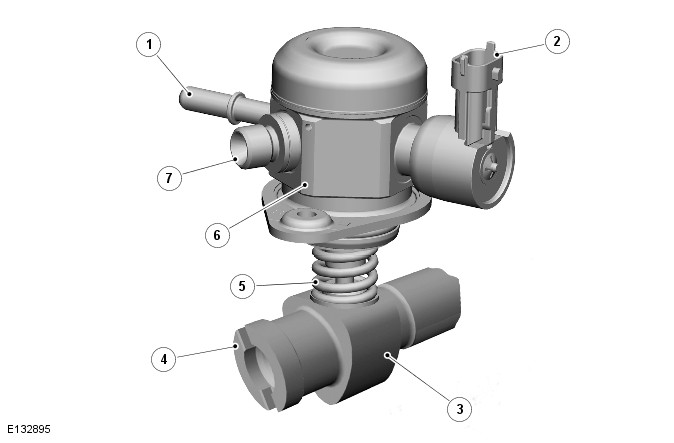
- Fuel inlet - low pressure
- Electrical connector
- Fuel pump lobes
- Exhaust camshaft
- Pump plunger
- Fuel metering valve connector
- Fuel outlet - high pressure to fuel rail
The high pressure fuel pump is a single cylinder pump which meters the fuel pressure according to demand requirements for correct fuel injection. The delivery rate of the fuel pump is adjustable by means of a fuel metering valve which is controlled by the ECM.
The high-pressure pump is mechanically driven by the camshaft via a plunger. During the downward stroke of the pump piston, fuel is delivered to the cylinder at a pressure supplied by the fuel tank mounted low pressure fuel pump. On the upward stroke of the piston the fuel in the cylinder is compressed. If the pressure from the pump exceeds the pressure in the fuel rail the fuel is delivered into the fuel rail via the high pressure outlet and a pipe.
The cylinder and low pressure fuel supply are connected via the fuel metering valve. If the fuel pressure in the fuel rail is sufficient, the ECM opens the metering valve during the compression stroke of the piston, decaying the pressure and directing the fuel from the cylinder back into the low pressure supply. A non-return valve is located between the fuel rail and the high pressure pump to prevent pressure dropping in the fuel rail due to fuel metering valve operation. The delivered fuel quantity depends on the engine speed and the actuation of the fuel metering valve.
Vacuum Pump
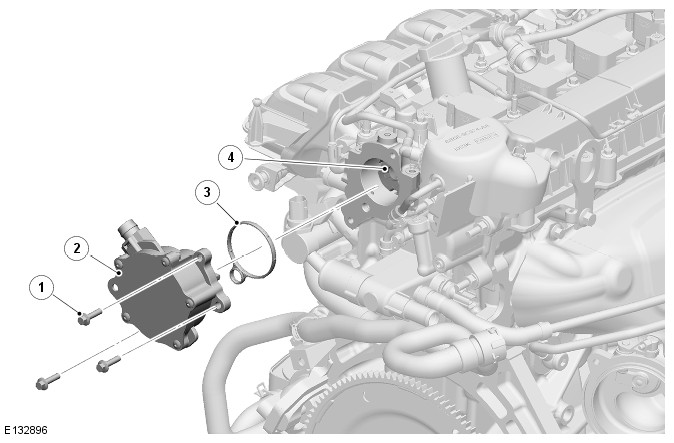
- Bolt (3 off)
- Vacuum pump
- Gasket
- Exhaust camshaft
The vacuum pump is located at the rear of the engine, adjacent to the high pressure fuel pump. The pump is attached to a machined hole in the cylinder head, sealed with a gasket and secured with three bolts.
The vacuum pump is driven by the inlet camshaft. Two tangs on the pump drive shaft mate with two slots in the end of the inlet camshaft and provide a positive drive between the two components. The vacuum produced by the pump is used to provide a vacuum for the brake booster on the braking system.
Engine - GTDi 2.0L Petrol
Lubricants, Fluids, Sealers and Adhesives

General Specification
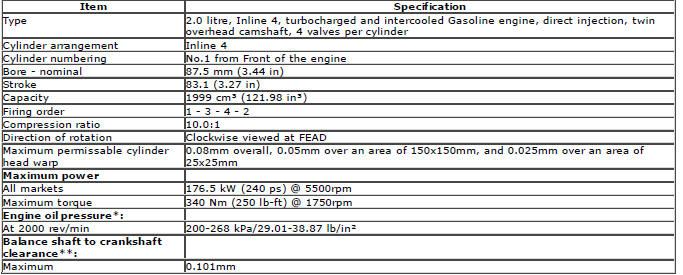
* Prior to checking the engine oil pressure, a road test of 6 miles (10
kilometres) must be carried out. Do not
attempt to attain normal engine operating temperature by allowing the engine to
idle.
**If the backlash between the balance shaft and crankshaft is greater than 0.101
mm then the balance shaft
assembly must be replaced.
Torque Specifications
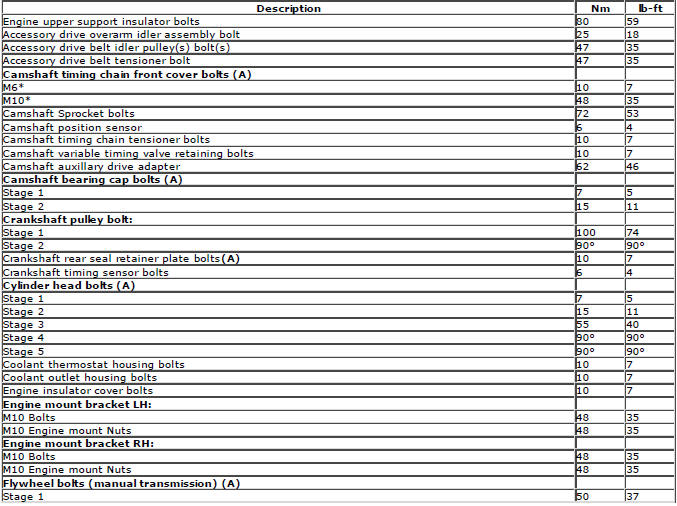
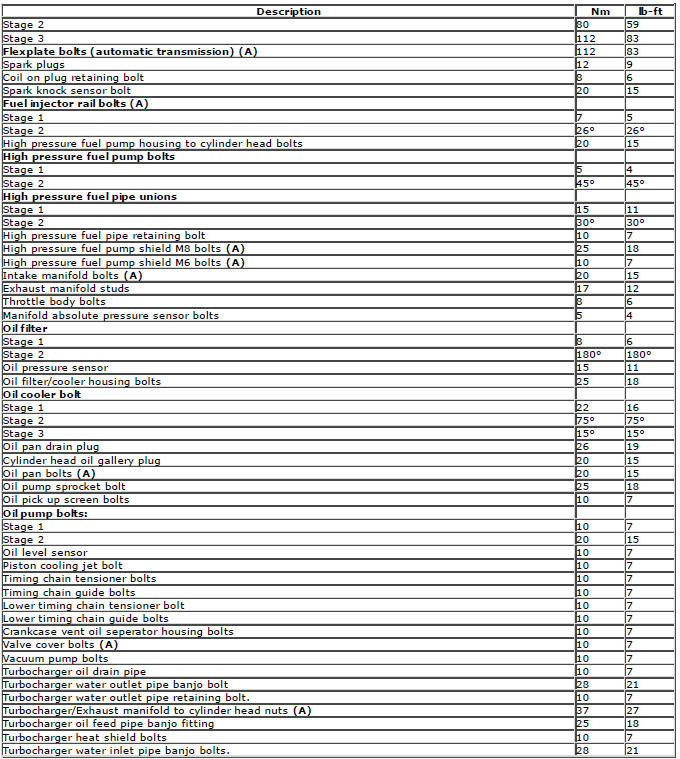
* New nuts/bolts must be fitted
A = refer to procedure for correct torque sequence

